Birds of prey, often known as raptors, are predatory creatures that target and kill animals via their powerful talons, acute senses, and sharp, pointy beaks.
Birds of prey had controlled the sky since the dinosaurs went extinct, from the microscopic falconet to the massive Andean condor.
Birds of prey include falcons, vultures, harriers, hawks, eagles, osprey, and owls. The Seriemas and Secretary Bird are both birds of prey, however, they are regarded to be outliers in comparison to the other categories.
With the exception of vultures, New Jersey is a habitat for several kinds of birds of prey.
This is an article about birds of prey in New Jersey, from the epic Golden eagle to a gigantic Black Vulture.
| Image | Name |
|---|---|
 | Rough-legged Hawk |
 | Broad-winged Hawk |
 | Red-tailed Hawks |
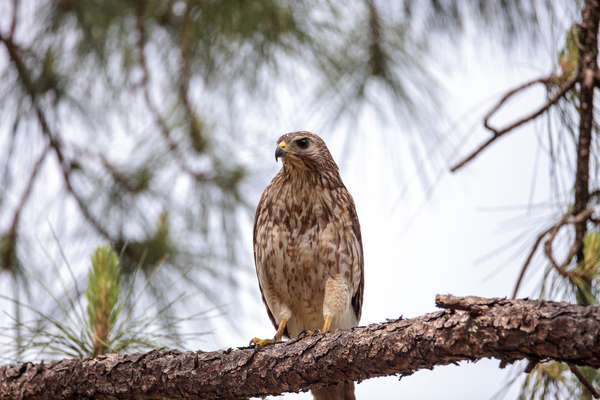 | Red-shouldered Hawk |
 | Northern Harrier |
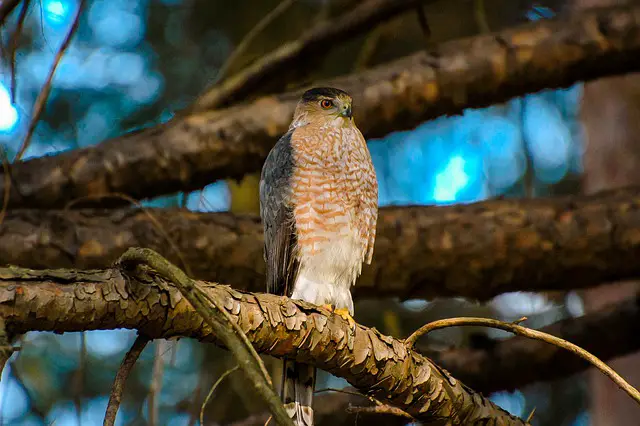 | Cooper’s Hawk |
 | Northern Goshawk |
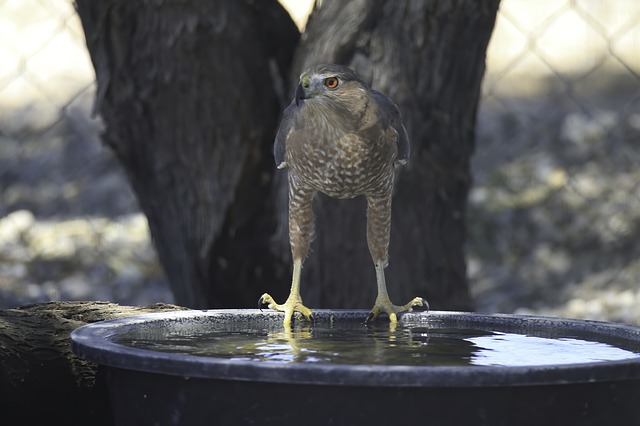 | Sharp-shinned Hawk |
 | Long-Eared Owl |
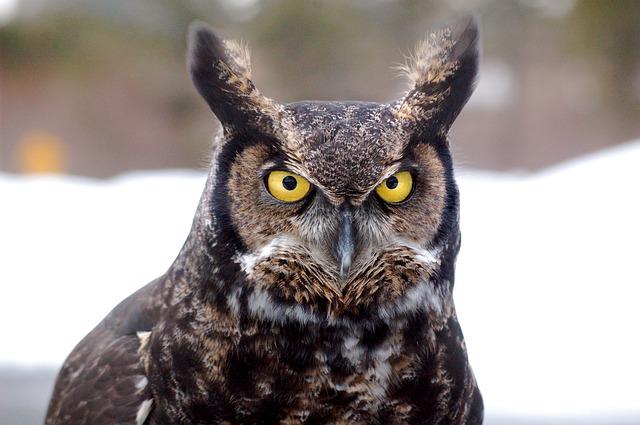 | Great-Horned Owl |
 | Northern Saw-whet Owl |
 | Barn Owl |
 | Short-Eared Owl |
 | Boreal Owl |
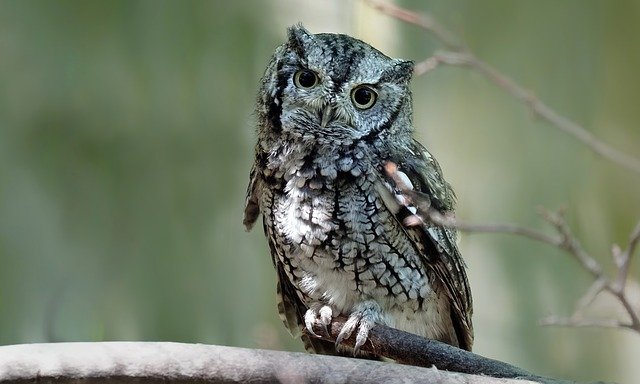 | Eastern Screech Owl |
 | Peregrine Falcon |
 | Golden Eagle |
 | Bald Eagle |
 | Turkey Vulture |
Birds of Prey in New Jersey
1. Rough-legged Hawk

Rough-legged Hawks travel from the Arctic and spend the winter across New Jersey. They are uncommon within the state, appearing in fewer than 1% of reports.
Rough-legged Hawks are most often seen flying across marshes and grassy areas or sitting on a pole.
Rough-legged Hawks get their name from their feathered legs, which help them stay warm in the north. They are huge hawks, around the proportions of a crow or a goose.
This mostly dark-drown variety may be found in both dark and light versions, having black patches at the bending of the tail end, wing, and abdomen. In comparison to certain other hawks, they possess wide wings that are relatively long and slender.
Rough-legged Hawks feed mostly on voles and lemmings. In areas like New Jersey, mice, ground squirrels, voles, and other small animals supply winter prey. They normally build their nests on a steep rock ledge and deposit 3 to 5 light whitish blue eggs.
2. Broad-winged Hawk

Broad-winged Hawks breed across New Jersey, although not in significant numbers, before flying towards South America in a whirling flock known as a kettle. They are seldom seen across New Jersey, appearing on fewer than 2% of ebird listings.
The autumn migration is the greatest time to view them.
The Broad-winged Hawk is a small, stocky bird that is about the dimensions of a crow or a goose. They possess barred chests, reddish-to-brown heads, and short rectangular tails that are tightly bonded.
These hawks target small animals, snakes, frogs, and even juvenile turtles from perches on the edges of woodlands or near water.
The Broad-winged Hawk frequently hatches 2 to 3 pale eggs within the nest of some other species, including a squirrel or crow.
3. Red-tailed Hawks

Red-tailed Hawks may be spotted across New Jersey the entire year and are frequent, accounting for more than 18 % of reports.
They also happen to be simplest to detect, especially on long vehicle rides, since they hover slowly across broad areas in search of prey. They are also seen perched atop utility poles.
The Red-tailed Hawk does have a characteristic short, broad red tail, as the names imply. They are huge, having wide, curved wings that are about the proportions of a crow or a goose. The majority of Red-tailed Hawks have a brown back and a light underbelly.
The Red-tailed Hawk’s high-pitched falling raspy-screech voice is frequently utilized in films to represent all raptors. Small animals, birds, and reptiles are among their favorite foods.
Nests are found among extremely tall trees, on rock ledges, and even on large structures or towers. They hatch 2 to 3 blotched white eggs.
4. Red-shouldered Hawk

The Red-shouldered Hawk may be seen across New Jersey throughout the year. In New Jersey, they were noted about 3 % of occurrence reports.
They are often found scavenging by a pond or lake among moist woodlands. Their prey consists of animals, snakes, and frogs.
Red-shouldered Hawks have black and white striped wings and a crimson stripe on the chest. They are medium-sized, something between a swan and a crow, and possess a heavily banded tail. They create a loud cack-cack-cack-cack-cack voice.
Nests are frequently reused in a broad-leaved tree near bodies of water that occur annually. They hatch between 2 and 5 white or blue eggs.
5. Northern Harrier

The Northern Harrier spends the whole year across New Jersey.
This short-tailed hawk may be observed skimming low across grassland and marshes.
These hawks are between the proportions of a crow and a goose, having long wide wings.
They frequently hover in a v-shape, with the points of their feathers higher than their bodies. Males are grey above and white below, with a white rump spot, while females appear brown.
Northern Harriers primarily feed on small animals and birds. They build their nests on the land in thick vegetation like willows, reeds, or brushtails. They produce 4 to 5 pale white eggs.
6. Cooper’s Hawk

Cooper’s Hawks may be spotted across New Jersey throughout the year. They are now more frequent than the Sharp-shinned Hawk, mostly in woods. They have been seen in 8 % of New Jersey listings.
Search for them on the outskirts of woodlands, although they may also be found at feeders searching for a quick meal.
Appearance
The Cooper’s Hawk resembles the Sharp-shinned Hawk but seems to be larger, approximately the proportions of a crow.
They may be difficult to distinguish since they possess the same bluish-grey back and red-orange chest, as well as black stripes on the tail. Unlike the Sharp-shinned Hawk, they possess a bigger head that extends far behind the wings.
They eat medium-sized birds and small animals and build their nests in towering trees, frequently on top of an existing nest of a big bird or mistletoe cluster. They produce between 2 to 6 bluish-white to light blue eggs.
7. Northern Goshawk

The Northern Goshawk is occasionally seen in New Jersey throughout the winter.
They reside across big woods and are difficult to locate, particularly since they are quite secretive and may be violent if you go too near to a nest.
Appearance
They are the larger and more aggressive cousins of the Sharp-shinned and Cooper’s Hawks. These hawks are around the proportions of a goose or a crow. They are primarily grey in color, with short, wide wings and a long tail. They have golden eyes with a white line above them.
Goshawks inhabit extensive areas of predominantly evergreen or mixed woodland. They hunt for food from high ledges and primarily consume medium-sized songbirds and tiny animals.
Northern Goshawks may build a maximum of eight nests and hatch between two and four bluish-white eggs.
8. Sharp-shinned Hawk

Although extremely migratory, the Sharp-shinned Hawk may be spotted across New Jersey throughout the year. They are spotted in 6% of New Jersey bird occurrences.
The Sharp-shinned Hawk represents New Jersey’s tiniest hawk. They appear smaller than crows but bigger than Jays.
Appearance
Females are one-third the size of males. They possess long, square-ended tails, short, curved wings, and tiny heads.
Sharp-shinned Hawk males possess a bluish-grey back and a red to the orange chest. Their tails are marked with black bands.
They are highly elusive; however, they may be observed flying through open regions at the margins of woodlands. They are quite fast and can sprint through deep woodlands to capture their food in flight, which is mainly songbirds.
They are occasionally observed grabbing tiny birds around feeders, but if you’re having issues with them around your garden, uninstall the feeder for a couple of days.
Food & Habitat
Sharp-shinned Before consuming their food, hawks pick it off a stump or low tree. They often feed on songbirds, a proportion of robins.
Sharp-shinned Hawk nests are commonly found within densely forested conifer trees, mainly at the tops of large trees. The nest is fairly huge, measuring 1 to 2 feet across and 4 to 6 inches thick. They hatch 3 to 8 speckled white or light blue eggs.
9. Long-Eared Owl

Long-eared owls seem to have hairy antennas around their heads. This bird of prey will be simple to identify.
Aside from its long ear form, the owl’s feathers have a wood-like pattern that hides it from prospective predators.
This owl, like many other owls, is primarily nocturnal, which means it hunts at night. Long-eared owls primarily hunt small mammals such as squirrels and rabbits. They swoop down to seize their prey, sometimes even during mid-flight.
Long-eared owls are adaptable hunters. They seldom go to the bother of building nests. Alternatively, they look for old ones from many different birds, such as crows.
This species prefers dense woodlands with a multitude of branches where it may obtain sufficient cover.
10. Great-Horned Owl

If you’ve previously spotted an owl throughout New Jersey, it’s quite likely that it was a great-horned owl.
Their magnificent plumage has given them the moniker “tiger owls.” The face discs of great-horned owls are orange, having black and white streaks surrounding their wings.
Food & Habitat
This owl is a vicious hunter. It hunts bigger prey like rabbits, squirrels, and rodents. It is not afraid to pounce on people that endanger its eggs, even humans. They are also not beyond devouring their own species, as well as other birds, such as crows.
If you’re having difficulty recognizing this owl, have a check now at unusually large ears. There’s a reason it’s known as a great-horned owl. These horned owls possess huge, gleaming golden eyes.
A great-horned owl may be found across both rural and urban environments. They’re not choosy regarding where they dwell because prey is what they’re chasing.
We suggest visiting your local park or woods, such as the Stokes State Forest, to obtain a closer look at the bird.
11. Northern Saw-whet Owl

Northern saw-whet owls are among the tiniest owls found in the state of New Jersey.
They have a round head and therefore are brown, having dirt to grey and white spots across their body and face.
Because the northern saw-whet owl usually appears active at night, finding it might be difficult. They also live within densely forested places and roost among tree trunks. Saw-whet owls, like many other owls, visit during the winter.
The simplest way to recognize the other is to listen for their characteristic “tooo-tooo” whistling call noises. You could also notice their trilling noises through the dense woods.
They’ll generally eat an insect-rich, protein-rich diet that includes rodents and lemmings.
12. Barn Owl

Barn owls seem to have been plucked from a fantasy film. The nicest thing regarding barn owls is that they are simple to recognize.
They have a huge flat snout that resembles an upside-down triangle and covers much of their face. Their hairline appears curved, similar to that of a sweetheart collar.
The face disc of a barn owl appears completely white, but the border, like the remainder of its wings, is a pale caramel tone. The hue darkens at the ends of its wings, like a burned caramel color.
However, their eyes have the same deep darkest brown color.
When searching for an owl, you may expect to notice hooting sounds; however, that is not the case with this owl. Barn owls make a scream-like squawk that’s also difficult to ignore.
13. Short-Eared Owl

Short-eared owls, as its name implies, possess round heads with little ear space.
This owl bears panda eyes having yellow irises within the center. They feature a splotchy plumage design having brown, black, and grey accents.
Short-eared owls often travel to New Jersey in the wintertime, just at the moment for mating season. They like to make their homes in forests or coniferous woods. The owls may also be seen flying in low areas and wide meadows, looking for smaller prey.
Because most open areas have been filled to prepare the way for agriculture, finding a short-eared owl could be more challenging.
As a result, you get a higher probability of finding them throughout the day since that is when birds start their search.
Search for a dog bark-line voice whenever you wish to utilize your hearing to locate a short-eared owl. Once they sing, they make their distinctive deep hooting sounds.
14. Boreal Owl

Boreal owls are not frequent migrants to New Jersey, although some residents have reported seeing them.
We wouldn’t be overly excited about this type of owl. If you come across one, appreciate it and attempt to catch it along with your camera. We’re certain the bird-watching society would welcome it too.
When you search for a fluffy cat, it appears overweight, but that’s only incredibly fluffy. That is the situation with the boreal owl. It possesses a bunch of feathers despite a very small body.
These little birds prefer a high-tree vantage point, where their frightening lemon-to-yellow eyes scan the forest canopy for unsuspecting mouse food.
Boreal owls possess a unique whistling calling sound that becomes increasingly higher as it advances. The younger ones make a “kip” noise.
15. Eastern Screech Owl

The remarkable V-shape in the middle of an eastern screech owl’s face is the initial thing you’ll remember about it. Their pointy tips resemble their ears.
Their plumage serves as an excellent camouflage for these owls. Because its feathers are predominantly dark and speckled with a few white spots, it fits within its wood-colored surroundings.
The eastern screech owl, such as the northern saw-whet, may be difficult to see. Whether you’re trying to observe birds, keep an ear out for a shrieking, almost harsh sound. It may resemble a horse whinnying.
Whether you’re trekking close to a river, you’ll have a good opportunity of seeing them because they’re generally around water.
Eastern screech owls will nest in any type of woodland as long as there are enough trees. You can have a harder time finding them in wide areas.
16. Peregrine Falcon

Peregrine Falcons species predatory birds that may be spotted throughout New Jersey and on every continent, excluding Antarctica. Due to their preference to nest on the tops of big buildings, these birds are prevalent across cities and could become regional superstars!
Appearance
Different birds and sexes have minor color differences. The backs of both genders are slate grey/bluish to black, having slight barring.
Their breast is white to brown, with small black lines running across them. Immature birds are frequently darker in color than adults. Females are bigger than males in virtually most falcon species.
Don’t believe the myth that now the cheetah seems to be the quickest animal. Certainly, they can get it up to 75 miles per hour (120 kilometers an hour), which is incredible when you’re on the ground.
Whenever a Peregrine Falcon dives, it may achieve speeds of up to 200 miles per hour (320 kilometers per hour)! And since it begins its voyage at 3,000 feet, it can travel at these incredible velocities for a long time.
Peregrine Falcons consume mostly other birds. In fact, at least 450 distinct bird species have been recognized as their prey. They really aren’t choosy and will eat practically everything, especially ducks, gulls, pigeons, and songbirds.
Except for the occasional warning cry near its nesting location, you didn’t believe them making much sound. It feels like “kack-kack-kack-kack-kack-kack . To listen to a sample, click the PLAY button underneath!
17. Golden Eagle

Golden eagles are very swift and nimble, making them excellent hunters. Whereas Bald Eagles primarily consume fish, these eagles virtually invariably consume animals.
Rabbits, ground squirrels, hares, prairie dogs, and marmots are among their preferred prey. These raptors, however, have been observed hunting and killing species as big as seals, small deer, coyotes, mountain goats, and badgers!
Appearance
Golden Eagles are beautiful dark brown birds that have gold plumage on the back sides of their throats, thus their name. White spots cover the wings and tails of immature birds. Adult Golden Eagles and juvenile Bald Eagles have similar appearances and may be readily fooled.
The difference between these two birds is that the Bald Eagle is not afraid to reveal a little leg, but the Golden Eagle retains plumes all the way back down to the tip of its feet.
These prey birds like large open environments across New Jersey, like mountains, cliffs, or hills. These birds may also be found among arctic tundra, grasslands, shrublands, farmlands, and coniferous woods.
These eagles are usually not particularly loud, and their cries resemble weak and loud whistles. For such a strong raptor, you’d imagine Golden Eagles, especially Bald Eagles, would emit a much scary sound!
18. Bald Eagle

The Bald Eagle is undoubtedly New Jersey’s most recognized raptor!
But did you realize that the “Bald” part of its name is not related to the fact that they don’t have plumage on their head? These eagles possess white plumage covering their whole face, with no bald patches to be seen. Their name originates from an Old English term that means “white patch” and alludes to their dazzling white heads.
While virtually everyone understands what a full-grown Bald Eagle appears like, identifying immature birds may be difficult. It takes FIVE YEARS for these eagles to develop their distinctive white head and dark brownish body.
Till then, these birds possess a variety of plumages as well as streaky brownish and whites on their bodies. Their beaks even alter color! It necessitates a great deal of knowledge and expertise to accurately recognize baby Bald Eagles!
Habitat
They are most frequently spotted near bodies of water. This is because they primarily consume fish! Search for them in marshes, lakes, rivers, and beaches. Forests surrounding huge bodies of water with excellent fishing AND towering trees for nesting places are the BEST choices.
The Bald Eagle certainly does not appear like you believe it does. You’d be mistaken if you imagined a menacing eagle call. They sound very much like gulls to me, with trills and small whistles.
In fact, movie filmmakers are so displeased with the sounds of a Bald Eagle that they often substitute the cry of a Red-tailed Hawk for a dramatic look!
19. Turkey Vulture

The Turkey Vulture, sometimes called the Turkey Buzzard, has become the most prevalent vulture across New Jersey and the nation as a whole.
They’re simple to spot since they’re entirely black, with a hairless redhead and a pink bill. Their name comes from their similarity to a wild turkey.
It’s simple to detect these vultures during flight once you understand what to search for. Check for a big raptor flying across the sky, making erratic loops with its wings stretched high enough to resemble the letter “V.” This soaring method is supposed to assist them in hovering at lower elevations, keeping them near the bottom to sniff for food.
Food & Habitat
To detect carrion, these prey birds employ their fully advanced smell sense. Their smell sense seems to be so acute they are able to identify dead meat from a distance of Eight miles (13 kilometers). These birds genuinely prefer fresh food and strive to reach animals as soon as possible once they die.
As you would expect, they are frequently observed along highways devouring animals that were struck by automobiles. They are often regularly seen flying in the open fields.
Whenever these raptors are scared, they may be so packed with flesh that they’re unable to fly away quickly. In this instance, they might projectile vomit everything they’ve consumed in order to reduce weight and flee.
Conclusion
These are among the most common birds of prayer in New Jersey. Many of these birds have already been sighted in large flocks at the same time.
New Jersey has a temperate climate, which implies that the state has pleasant summers and frigid winters. This is good for hawks who must migrate owing to harsh seasonal circumstances.
FAQ
What is New Jersey's biggest hawk?
Northern Goshawks, notably Cooper’s and Sharp-shinned Hawks, are accipiters with curved wings and long tails. Northern Goshawks, in contrast, are significantly larger compared to these other accipiters, and they are the biggest accipiters across North America.
What is New Jersey's largest bird?
The albatrosses are one of the biggest flying birds, with the genus Diomedea’s great albatrosses having the longest wingspans of almost any living bird. Throughout New Jersey, two species were identified.
Last Updated on March 22, 2023 by Lily Aldrin
